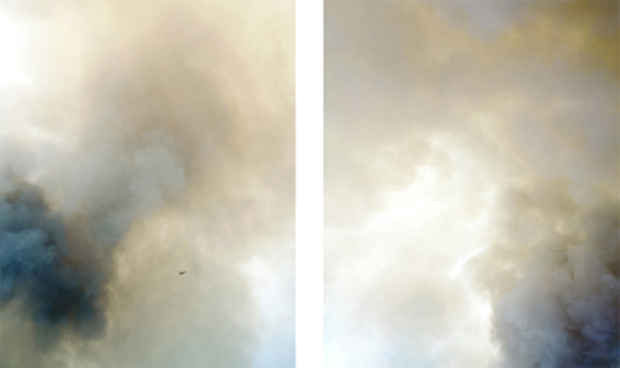"The Perfect Storm" Exhibition
Julie Saul Gallery

This event has ended.
The Julie Saul Gallery presents "The Perfect Storm", a group exhibition exploring man-made and natural disasters. The selected artists use their work as a conduit to address environmental, political and economic issues, each exploring man’s tenuous relationship to nature in a global landscape fraught with uncertainty. The destructive forces of nature, global warming, “the war on terror” and financial uncertainty are all challenges we face today.
Televised news and the internet are the most common visual sources of disaster coverage, spreading images of destruction to the public on a daily basis. We see the aftermath of tornados, tsunamis, forest fires or terrorist attacks captured in real-time. Each of the artists in this show have been affected by this inundation of media imagery and has responded in an individual way.
Climate change is issue which often remains under the surface, a repressed knowledge of our uncertain future. "Black Smoke" a ship caught in an apocalyptic explosion of the artist's making is part of Sarah Anne Johnson's "Arctic Wonderland" series. Photographed during a residency to the Arctic Circle, Johnson altered the print surfaces using various manipulations "to show not just what I saw, but how I feel about what I saw". Julie Heffernan's paintings from the past year also focus on the havoc man is causing to the planet. Embellished with symbolic references, Heffernan paints a prophetic narrative of self-destruction and possible end to the world.
In Karin Apollonia Müller’s diptych "Griffith" a helicopter hovers in the dark smoke of an assumed forest fire, the photographer's presence creating a tension common in Müller’s "On Edge" series. Inspired by "accidents and incidents, both big and small that disrupt the picture we look at.. I wanted to evoke an elevated level of anxiety, brought on by our witnessing of the systems we've created reaching their breaking points, and the realization that we don't seem to be able to maintain the world we've created for ourselves".
Tom Berenz blurs the line between reality and abstraction in his paintings of natural disasters. "Flood 3", part of a series created in response to the "Big Three" automotive industry bailout depicts cars floating in an asymmetrical pattern in murky flood water. One clearly defined hub cap is the observers only concrete cue to its being.
Weather disasters linked to home unify Lori Nix and Yuki Shingai's photographs. "Floating House" was inspired by Nix's childhood growing up in rural western Kansas where natural disasters were a common occurrence. Fabricated in the studio, Nix manifests this past into miniature environments; evoking what a child might see when enveloped in such an experience. Living in New York at the time of the earthquake and tsunami that devastated Japan in 2011, Shingai was forced to obtain information about her homeland through the news and internet. Facing away from the ocean, Shingai stages pairs of shoes standing stoically and in line formation in the place of the people who are absent. A bird flying overhead is the only witness to the scene, offering the suggestion of life.
Simen Johan's, "Untitled #156" is a mixture of natural and artificial elements put together to create a visual distortion that feels fabricated and grotesquely surreal. The scene suggests an oil spill, the animals frozen in terror.
On September 11, 2001 Bill Jacobson felt compelled to go out and photograph. Best known for his out-of-focus imagery and working on urban street scenes at the time, Jacobson shot the devastation of the World Trade Center collapse from a distance, a large cloud of smoke seen through an empty space in the city street. Viewed a decade later, the image can be seen as a visual memory of the fog of uncertainty experienced that day.
Philip-Lorca diCorcia's "East of Eden" series is a modern take on the Book of Genesis mixed with the current economic crisis and political climate in the United States. DiCorcia states, "It was kind of provoked by the collapse of everything, which seems to me a loss of innocence. People thought they could have anything. And then it just blew up in their faces". In a staged setting, a lone woman sits on the edge of a bed in an empty room overlooking the city. A conversation of turmoil implied by the tornado brewing on a flat screen tv out of her view.
We cannot escape the complexities of our world, nor the effects its advancement has caused to the environment and man.
Curated by Edna Cardinale
Summer hours:
June: Tuesday-Saturday 11-6 pm
July/August hours: Tuesday-Friday 10-5 pm
Media
Schedule
from June 28, 2012 to August 17, 2012
Summer hours: June: Tuesday-Saturday 11-6 pm July/August hours: Tuesday-Friday 10-5 pm
Opening Reception on 2012-06-28 from 18:00 to 20:00